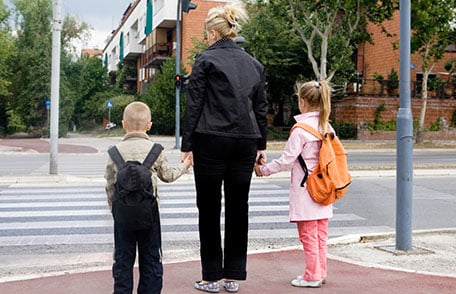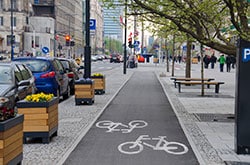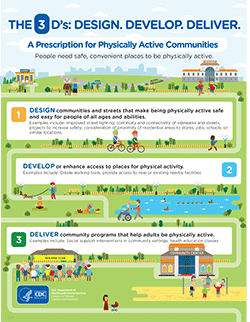Designing Walkable Communities

Learn how improving walkability provides many opportunities for people to be physically.
Walking is an excellent way to help people become more active and improve their health. It is an easy way to begin and maintain a physically active lifestyle, and it is the most common form of physical activity for people across the country. People walk for many purposes, such as for transportation to get to school or work, for leisure to have fun, or to improve their health.
Ultimately, individuals make the decision to walk. However, the decision to walk can be made easier by improvements to community walkability. Improving walkability means that communities are created or enhanced to make it safe and easy to walk and that pedestrian activity is encouraged for people of all ages and abilities. For example, community design can locate residences within short walking distance of stores and public transportation. Sidewalks or paths between destinations can be designed and maintained to be well-connected, safe, and attractive. Transportation and travel policies that create or enhance pedestrian and bicycle networks or expand public transportation systems can be another approach to encourage active transportation, such as walking or biking. Improving walkability of communities can also help people who participate in other types of physical activities, such as those who bike or use wheelchairs.
Creating or modifying environments to make it easier for people to walk or bike is a strategy that not only helps increase physical activity, but it can also make communities better places to live. Studies show more people bike and walk in communities where improvements have been made, such as adding safer sidewalks, pedestrian crossings, and protected bike lanes. In addition, when people move to neighborhoods that are designed to promote physical activity and active transportation, they tend to spend less time in their cars and more time walking for transportation. Making walking easier can also help communities by improving safety, increasing interaction between residents, improving local economies, and reducing air pollution.
To make more communities walkable and help more people walk enough to reap health benefits, we need increased collaboration within and across sectors, such as transportation, community planning, and public health. In September 2015, the Office of the Surgeon General in the US Department of Health and Human Services released Step It Up! The Surgeon General’s Call to Action to Promote Walking and Walkable Communities to recognize walking as an important way to promote physical activity among most people. This Call to Action describes five goals and supporting implementation strategies that multiple sectors of society can use to promote walking and walkable communities.
The Three Ds of Physically Active Communities:
- DESIGN communities and streets that make being physically active safe and easy for people of all ages and abilities.
- DEVELOP or enhance access to places for physical activity.
- DELIVER community programs that help adults be physically active.
More Information
- STEP IT UP! The Surgeon General’s Call to Action to Promote Walking and Walkable Communities
- Combined Built Environment Features Help Communities Get Active
- Status Report of the Call to Action[1.24 MB]
- 2008 Physical Activity Guidelines for Americans
- Health Benefits of Physical Activity
- The Community Guide
- CDC’s Designing and Building Healthy Places
























.png)











No hay comentarios:
Publicar un comentario